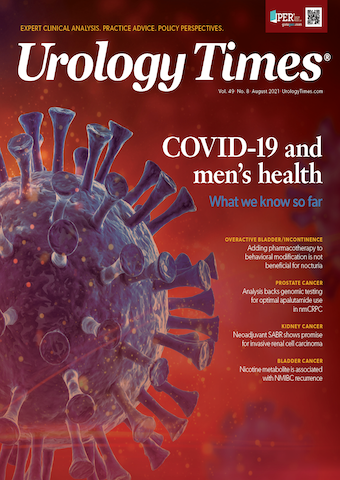Publication
Article
Urology Times Journal
2022 CMS proposed rule represents another mixed bag for urologists
Author(s):
Conversion factor is expected to decrease by 3.89%
Jonathan Rubenstein, MD

The Centers for Medicare & Medicaid Services (CMS) released its proposed rules for the Medicare Physician Fee Schedule on July 13, 2021, and for the Hospital Outpatient Prospective Payment System and Ambulatory Surgical Center Payment System on July 19, 2021. In this article, we will highlight a few items of note for the physician fee schedule.
This year’s proposed rule, as usual, is a mixed bag for urology. A very important takeaway is that this is a proposed rule and not the final rule, and we will not know for certain the actual effects on urology until the final rule is published. We have seen years in which there were significant changes and 180-degree turns between the proposed and final rules. Therefore, please take a deep breath when reading this article, because there will be a comment period when individuals, groups, and
Mark Painter

societies are able to give feedback to CMS on how the proposed policies will affect their groups. These comments will allow CMS to better understand some of the downstream effects of its proposed policies. CMS is required by law to acknowledge and respond to each comment directly or grouped with similar comments submitted. We encourage reaching out to your society with comments about the rule and to consider submitting comments directly to Medicare. For instructions on how to submit comments to CMS and to read the full rule, use this link: https://public-inspection.federalregister.gov/2021-14973.pdf
Financial impact
The conversion factor is projected to decrease by 3.89%, which directly affects physician payment for work performed to Medicare and Medicare Advantage plans. This decrease is primarily due to the expiration of a 1-time contribution from the Trust Fund as part of the Consolidated Appropriations Act, 2021, which lifted the conversion factor by 3.75% for the 2021 calendar year only. As the changes to urology as a specialty code RVU changes net a 0% change when volume of services are considered across all urologists, the net decrease for Urology as a specialty will be 3.89%. However, the impact to each urology practice will vary based on case mix.
There was a change in the proposed rule that, if finalized, could significantly change the reimbursement for urology services, which was likely an unintended side effect of what was meant to be a positive change. The way clinical staff has been valued has not been updated in nearly 2 decades, and that work is proposed to be updated starting in 2022. However, due to the need for budget neutrality, this increase in clinical staff value led to a decrease overall in practice expense relative value units (RVUs), with the net effect of possible significant reductions in overall reimbursement of many office- and hospital-based procedures performed by our specialty. For example, although there is no change in the work RVU of most urologic diagnostic and therapeutic urology procedures, the reduction in practice expense due to this change would significantly reduce the nonfacility and facility payment for commonly performed urologic procedures such as prostatic urethral lift (current procedural technology [CPT] codes 52441 and 52442), transurethral destruction of prostate tissue by radiofrequency-generated water vapor thermotherapy (CPT 53854), and other minimally invasive prostate therapies. A table that can be accessed by going to https://bit.ly/3ym85nz. includes a list of procedures commonly billed by urologists with a projected percentage change of >5% (increase or decrease) in the nonfacility (ie, office) and facility (ie, hospital) settings. Once again, please remember that this is a proposed rule and not the final rule.
Quality Payment Program
Each year, the Quality Payment Program (QPP) is updated. For calendar year 2022, CMS is proposing to require clinicians to meet a higher performance threshold to be eligible for incentives. This new threshold aligns with the requirements established for the QPP’s Merit-based Incentive Payment System (MIPS) under the Medicare Access and CHIP Reauthorization Act of 2015.
Additionally, CMS is proposing to change the QPP system in an attempt to make measures broader and more applicable to patient care. The transition is proposed to begin in 2023 with a change to MIPS Value Pathways (MVPs). The initial set of proposed MVP clinical areas includes rheumatology, stroke care and prevention, heart disease, chronic disease management, lower extremity joint repair (eg, knee replacement), emergency medicine, and anesthesia. CMS says MVPs will more effectively measure and compare performance across clinician types and provide clinicians more meaningful feedback.
Evaluation and management changes
CMS is proposing to reconcile the difference in the CPT language for in-office shared/split visits that were included in the guidelines for the changed office visit codes. In the proposal, CMS will expand the ability to bill for a shared/split visit to any facility setting and is including critical care codes and the facility-specific evaluation and management (E/M) categories. It is also proposing to allow selection of the appropriate visit level using either medical decision-making or time; however, it will designate that the billing for a qualified health care professional (QHP) such as a physician, physician assistant (PA), or nurse practitioner (NP), must document that they spent the most time on the date of service in providing the E/M service. CMS also has proposed the creation of a new modifier to indicate that the visit was a shared/split visit. This will require both documentation changes and billing changes for those visits in which more than 1 QHP participates in the facility-based E/M service. The billing provider must sign the medical record for the visit and documentation must support the time spent by the billing provider was greater than time spent by the other “employed” practice member(s) sharing/splitting the visit, regardless of how the level of visit was selected.
In the office setting, shared/split visits will not be allowed. CMS has proposed that “incident to” rules will continue to be the appropriate way to classify services provided in the office setting. The time with the patient rule does not appear to apply in the office setting, as “incident to” rules do not require direct patient physician contact in the office setting if the services are provided by an appropriately contracted person in the group, provided the “incident to” rules are met.No changes were proposed to the “incident to” rules. We have seen many practices struggle with “incident to” billing for advanced practice providers (APPs); it is worth reviewing these guidelines and your practices policies every year, including this year and next.
CMS also stated that Medicare will not recognize modifier -52 with E/M codes.
Advanced practice providers
CMS has traditionally classified advanced practice providers (APPs) under a taxonomy code that does not specify the specialty of the PA or NP based on their group’s specialty. In this proposed rule, CMS has indicated that the APP will be considered a specialist designated by their “employer” for the purpose of shared/split billing.
CMS is also proposing to allow PAs to directly participate in the Medicare program. Previously, a PA had to be contracted or employed by another qualified Medicare entity in order to bill Medicare.
These changes in PA status are reflective of the growing contribution that PAs make in the US market for both access to care and the increase in the team approach to health care.
Telehealth
As we have stated previously, Medicare does not have the legislative power to open telehealth provided to patients outside a Medicare-approved facility once the Public Health Emergency (PHE) for COVID-19 expires (now scheduled to end October 18, 2021, but expected to be extended at least through the end of 2021). In this proposed rule, CMS is proposing to expand the number of services covered under telehealth rules both permanently and temporarily.
The current list of codes considered allowable under telehealth includes 3 separate categories. The category 1 codes are permanent, category 2 codes are expected to become permanent, and category 3 codes are considered to be temporary to help address patient needs during the COVID-19 pandemic. CMS is proposing that all codes from categories 2 and 3 will remain covered services under telehealth rules until 2023 or the end of the calendar year in which the COVID-19 PHE expires, whichever is later.
After the PHE expires, CMS will no longer cover codes 99441 to 99443 (telephone only) visits, but will revert to codes G2250 to G2253 for virtual check-in visits and the codes for virtual management of non-telehealth remote visits. The rules for use of these codes are not proposed to change. Once the PHE ends, you will need to review the requirements for the use of these codes if there is no legislative change to telehealth.
CMS is expanding coverage for remote management of patients based on a series of new codes to be added to CPT for remote therapeutic monitoring (RTM). These codes appear to focus on remote monitoring for disease states related to neurologic and orthopedic surgery and other short-term but higher-risk problems for the which the patient is being treated. These new RTM codes do not appear to require 16 days of monitoring within a month, as required by current remote patient monitoring codes. The RTM codes appear to be intended to fill a coverage gap for some emerging technologies.
There are a number of bills circulating in Washington to permanently expand telehealth coverage to patients in their home; we will continue to monitor the progress of these bills.
Summary
Again, we encourage you to comment on those parts of the proposed rules that you feel are incorrect or misguided. Your comments need to be coherent, and keep in mind the overall goals of patient care under the Medicare program. CMS is required to respond to all comments. We would also encourage you to work in conjunction with urology specialty societies such as the American Urological Association, Large Urology Group Practice Association, American Urogynecologic Society, and the American Association of Clinical Urologists, among other societies including state and national organizations that support your positions. And again, please remember that as of now, this is just a proposed rule.
Rubenstein is compliance officer and medical director of coding and reimbursement, United Urology Group and Chesapeake Urology, Towson, Maryland. Painter is CEO of PRS Urology SC in Denver, Colorado.
The information in this column is designed to be authoritative, and every effort has been made to ensure its accuracy at the time it was written. However, readers are encouraged to check with their individual carrier or private payers for updates and to confirm that this information conforms to their specific rules.
Newsletter
Stay current with the latest urology news and practice-changing insights — sign up now for the essential updates every urologist needs.























